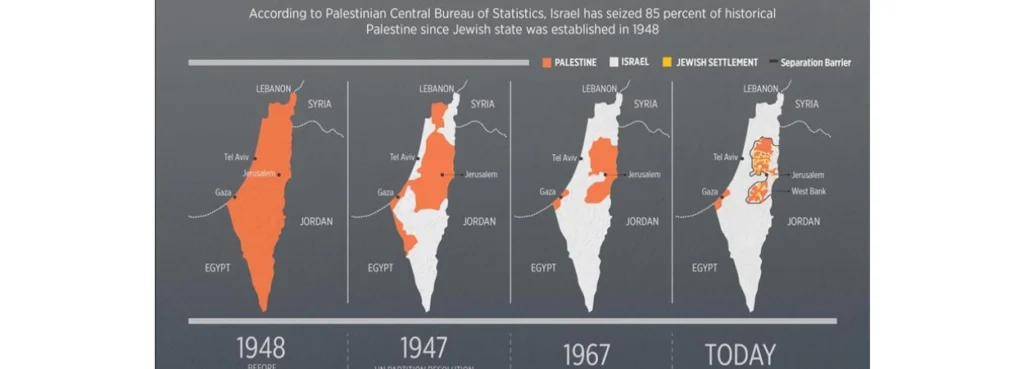On 7th October 2023, Hamas fighters invaded southern Israel leading to a war between Hamas-led Gaza and the State of Israel. In this brutal attack, approximately 1400 Israelis were killed and more than 250 were kidnapped. In response to this attack, Israel has bombed the Gaza Strip mercilessly. This horror attack has ignited the discussion on “Two-State Solution”. In this article, we will discuss the genesis of the “Two-State Solution” and the events that have culminated in this horrific attack.

I. Understanding the Two-State Solution
A. origins of the idea
The concept of a Two-State Solution has deep historical roots, dating back to the 1948 Arab–Israeli War. The United Nations proposed a partition plan, suggesting separate Jewish and Arab states. Although neighbouring Arab countries attacked the State of Israel the next day it was established leading to the 1948 war which resulted in Israel occupying more Palestininan territory than assigned and Egypt ( Gaza Strip) and Jordan ( West Bank ) occupying the mandated Palestinian state.
B. 1967 War
In this War, Israel occupied the whole of the Mandated Palestinian State thus making the possibility of an independent Palestinian State a distant dream.
C. Oslo Accords and the two-state vision
The Oslo Accords of 1993 was an important step towards the two-state solution. The agreement between Israel and the Palestine Liberation Organization (PLO) was intended to address fundamental issues, providing hope for the establishment of an independent Palestinian state alongside Israel.
II. Historical Context
A. First Intifada
The term “intifada”, represents the Palestinian uprisings. The First Intifada (1987–1993) reflected the frustration and resistance of the Palestinian population, which influenced the dynamics leading to the Oslo Accords.
B. Oslo Accords and Two-State Vision
The Oslo Accords of 1993 were a watershed moment towards a two-state solution. The agreement between Israel and the Palestine Liberation Organization (PLO) was intended to address fundamental issues, thereby providing hope for the establishment of an independent Palestinian state alongside Israel.

III. Challenges to Implementation
A. Territorial Disputes
One of the primary challenges facing the implementation of a two-state solution is the delineation of borders. Territorial disputes, especially in the West Bank, have proven to be a persistent obstacle, requiring delicate negotiations to find mutually agreeable solutions.
B. Status of Jerusalem
The status of Jerusalem remains a controversial issue with deep religious and cultural significance. Determining its position in the context of a two-state solution requires careful consideration and diplomatic finesse.
C. Right of Return
Addressing the right of Palestinian refugees to return to their homes has long been a point of contention. Balancing this humanitarian concern with ensuring the stability of both states is a complex challenge in two-state settlement talks.
IV. prospects for peace
A. Security and stability
One of the potential benefits of a two-state solution lies in its ability to provide a framework for increased security and stability in the region. Clearly defined borders and cooperative security measures can make an important contribution to long-term peace.
B. international support
The international community widely supports the idea of a two-state solution. Major world powers and international organizations advocate for a resolution that respects the rights and aspirations of both Israelis and Palestinians, adding a layer of legitimacy and support to the process.
V. Overcoming Obstacles
A. diplomatic engagement
Sustained and meaningful diplomatic engagement is critical to overcoming obstacles to a two-state solution. Both parties must commit to negotiations addressing the core issues with the intention of reaching a mutually acceptable agreement.
B. Building Trust
Building trust between Israelis and Palestinians is paramount to the success of a two-state solution. Confidence-building measures, transparency, and adherence to agreements can create an environment conducive to successful implementation.
VI. conclusion
In conclusion, the Two-State Solution presents a potential opportunity to resolve the deeply rooted Israel-Palestine issue. Despite challenges such as territorial disputes, the status of Jerusalem, and the right of return, the historical context and international support provide hope for a future where Israelis and Palestinians will co-exist peacefully as two sovereign states. Overcoming these challenges will require commitment, diplomacy, and a shared vision for a stable and prosperous future.




